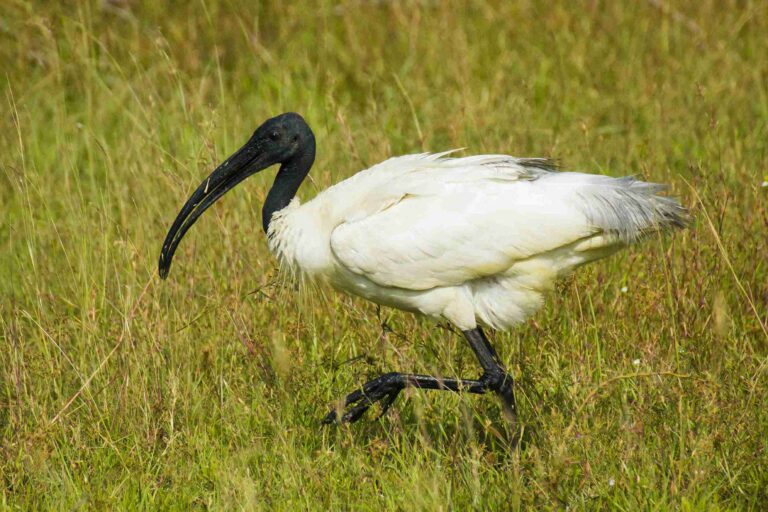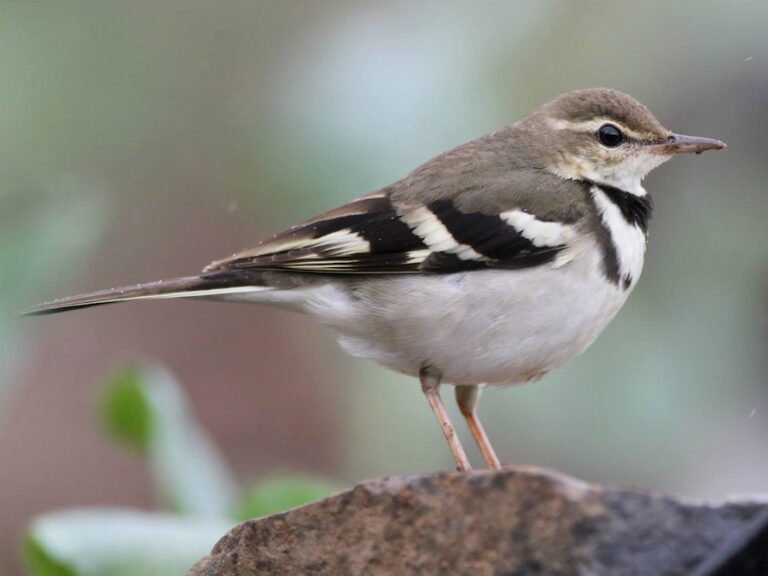11 Black Birds with White Belly (ID Guide With Photos)
If you’re a birdwatching enthusiast you might be familiar with various bird species. But what about black birds with white belly? These unique creatures showcase a stunning contrast that is sure to captivate your attention. From the intelligence of the black-billed magpie to the striking appearance of the Atlantic puffin, get ready to discover 11 fascinating black birds with white bellies in this comprehensive ID guide. Prepare to be amazed by the diversity and beauty found in these remarkable species.
Key Takeaways:
- Explore the captivating world of black birds with white belly
- Discover the distinctive features and behaviors of each species
- Learn where these birds can be found and their preferred habitats
- Appreciate the importance of black birds with white belly in the ecosystem
- Gain a deeper understanding of the avian world and its marvelous diversity
1. Black-Billed Magpie (Pica hudsonia)
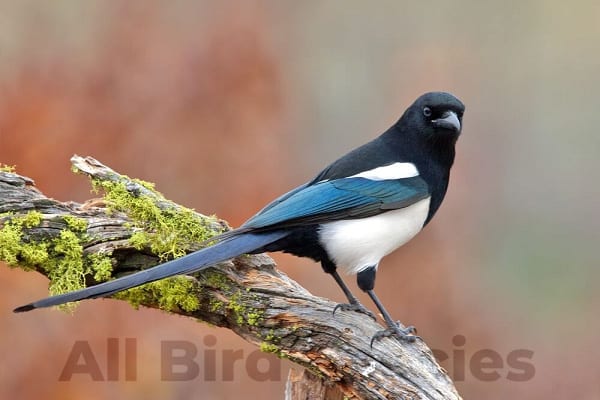
The black-billed magpie, scientifically known as Pica hudsonia, is a stunning bird that sports a sleek black plumage accompanied by a striking contrasting white belly. Found predominantly in the western parts of North America, these magpies captivate with their intelligence and bold personalities.
Did you know? The black-billed magpie is known for its mischievous nature and thieving habits. They are notorious for collecting shiny objects and incorporating them into their nests!
With their elegant appearance and distinctive coloring, black-billed magpies are easily recognizable in both urban and rural settings. Let’s take a closer look at some key characteristics and behaviors of these fascinating birds:
Appearance
The black-billed magpie is a medium-sized bird, measuring approximately 18-24 inches in length. Its black plumage covers the body, wings, and tail, while the contrasting white belly adds a touch of brilliance. The long tail, often fanned out, further enhances its overall allure.
Habitat and Range
Black-billed magpies are primarily found in the western regions of North America, including areas such as British Columbia, Alberta, and the United States’ Rocky Mountains. They thrive in a variety of habitats, including woodlands, forests, grasslands, and even urban environments.
Must Read Types of Finches in Michigan
Behavior and Communication
These highly social birds are known for their complex social behaviors. They form loose family groups, often observed engaging in mutual grooming and playing. Black-billed magpies are also exceptionally skilled mimics, capable of imitating the calls of other birds and even human voices.
Their vocalizations serve various purposes, including territorial defense, attracting mates, and communicating with other group members. Their repertoire of sounds includes harsh calls, rattling noises, and melodious songs.
Diet
Black-billed magpies have an omnivorous diet, feeding on a wide variety of food sources. Their menu includes insects, small mammals, eggs, berries, fruits, seeds, and even carrion. They are opportunistic foragers and are known to scavenge on roadkill and garbage.
Conservation Status
The black-billed magpie is not currently considered a species of conservation concern, although populations may face localized threats such as habitat loss and persecution. These adaptable birds have successfully adapted to human-altered environments, which has helped sustain their populations in many areas.
| Scientific Name | Common Name | Habitat | Range |
|---|---|---|---|
| Pica hudsonia | Black-Billed Magpie | Woodlands, forests, grasslands, urban environments | Western regions of North America |
2. Black Skimmer (Rynchops niger)

The Black Skimmer is a fascinating seabird known for its unique appearance and hunting technique. Scientifically known as Rynchops niger, this species showcases a striking contrast between its black upper body and white underbelly, making it a standout among black birds with white belly. Black Skimmers are specially adapted for skimming the water’s surface in search of prey, making them a remarkable sight for birdwatching enthusiasts.
Distinctive Features
- Black upper body and contrasting white underbelly
- Long, slender wings
- Knife-like bill with a lower mandible longer than the upper
Black Skimmers are easily recognizable due to their distinct features. Their black plumage provides camouflage for their upper body, while the white belly adds a striking visual contrast. These birds have long, slender wings that enable them to glide effortlessly over the water’s surface. The most remarkable feature is their unique bill, which is specially adapted for their hunting technique. The lower mandible of their bill is longer than the upper, allowing them to skim the water and snatch up fish with precision.
Few species can rival the Black Skimmer’s mesmerizing hunting skills. As they gracefully glide just above the water’s surface, their lower mandible skims through, creating a wake that disturbs small fish. With lightning-fast reflexes, they snatch up their prey, making it look like a carefully choreographed dance.
Habitat and Distribution
Black Skimmers can be found along the coastal areas of North and South America, including the Gulf Coast, Atlantic Coast, and Pacific Coast. They are primarily found in areas with sandy beaches, estuaries, and salt flats. These birds prefer nesting on open beaches or sandbars where they can establish colonies.
Also read Types of Owls in Arkansas
Conservation Status
The Black Skimmer is listed as a species of least concern on the IUCN Red List. However, they face various threats, including habitat loss due to coastal development, disturbance at breeding colonies, and pollution. Conservation efforts focus on protecting their nesting sites and raising awareness about the importance of preserving coastal habitats.
| Species | Conservation Status |
|---|---|
| Black Skimmer | Least Concern |
3. Black Phoebe (Sayornis nigricans)

The black phoebe, scientifically known as Sayornis nigricans, is a small flycatcher species found in western North America. Despite its name, this bird’s most distinguishing feature is its crisp white belly contrasting with its black plumage.
The black phoebe is known for its compact size, measuring around 6 inches in length. It has a black head, back, wings, and tail, which create a striking contrast with its white belly. This species displays minimal sexual dimorphism, with males and females exhibiting similar plumage.
Black phoebes have a distinct flight pattern, characterized by their quick and agile movements as they hunt for insects. They are often seen perched on branches, posts, or rocks near water sources, scanning the surroundings for potential prey. When they spot an insect, they launch into action, darting out to catch it in mid-air before returning to their perch.
These birds are primarily insectivorous and have a diverse diet that includes flies, beetles, bees, wasps, and other small invertebrates. They rely on their aerial acrobatics and sharp eyesight to locate and capture their prey.
Key Features of the Black Phoebe:
- Black plumage
- Crisp white belly
- Compact size (around 6 inches in length)
- Minimal sexual dimorphism
- Quick and agile flight pattern
- Insectivorous diet
Did you know? The black phoebe is an adaptable species and can be found in a variety of habitats, including streams, ponds, marshes, and urban areas. They are known to build their nests on rocky ledges, bridges, buildings, and other man-made structures.
If you enjoy birdwatching, keep an eye out for the black phoebe during your excursions. Its distinctive black-and-white plumage and active foraging behavior make it a delight to observe in the wild.
| Species Name | Scientific Name | Size | Plumage | Behavior | Habitat |
|---|---|---|---|---|---|
| Black Phoebe | Sayornis nigricans | Around 6 inches | Black with a white belly | Quick and agile flight pattern, insectivorous diet | Streams, ponds, marshes, urban areas |
4. Black-Necked Stilt (Himantopus mexicanus)
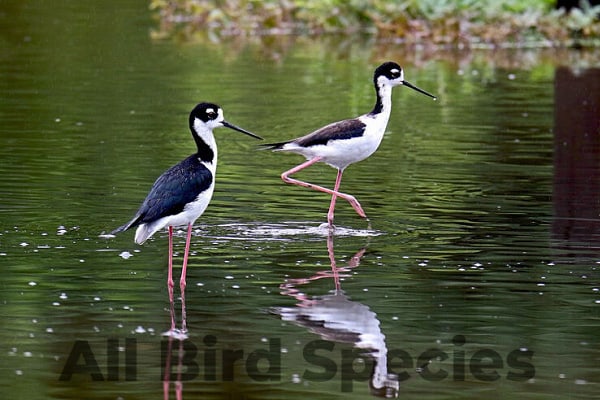
The black-necked stilt, scientifically known as Himantopus mexicanus, is a striking shorebird that captivates with its long, slender legs and striking black-and-white plumage. Found in wetlands and marshes across the United States, this elegant bird stands out with its distinctive appearance and graceful movements.
The black-necked stilt is known for its exceptionally long legs, which allow it to wade through shallow waters and forage for food. With its black upper body and contrasting white belly, this species exemplifies the beauty of black birds with white belly. Its slender, delicate beak is perfectly adapted for capturing small aquatic invertebrates, crustaceans, and insects.
Must Read Birds With Orange Chests of North America
Notable behaviors of the black-necked stilt include its graceful walking and probing techniques in search of prey. It often uses its slender bill to sweep back and forth in the water, capturing unsuspecting prey. This shorebird is known for its territorial behavior, vigorously defending its nesting area from intruders.
The black-necked stilt is an exceptional avian species, and its characteristics make it a favorite subject for birdwatchers and photographers alike. Whether observed individually or in groups, this bird’s striking black-and-white plumage never fails to capture attention and admiration.
“The black-necked stilt is a true example of nature’s artistry, with its long legs, eye-catching plumage, and graceful presence. Its black-and-white beauty contrasts beautifully against its wetland habitats.”
| Common Name | Scientific Name | Physical Features | Habitat | Diet |
|---|---|---|---|---|
| Black-Necked Stilt | Himantopus mexicanus | Long legs, black body, white underbelly | Wetlands, marshes | Aquatic invertebrates, crustaceans, insects |
5. Razorbill (Alca torda)
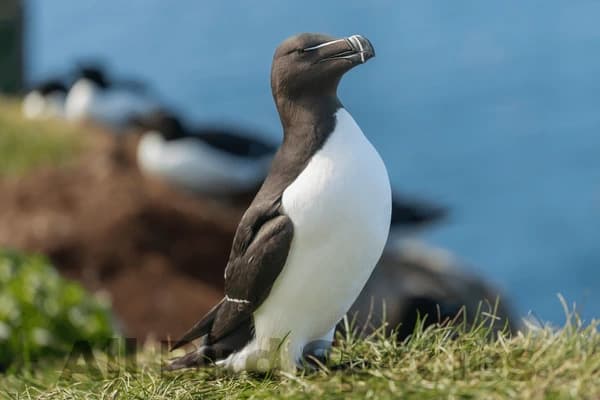
The razorbill, scientifically known as Alca torda, is a large seabird that inhabits the North Atlantic. With its black body, white belly, and distinctive deep beak, this bird is perfectly suited for diving and catching fish in the ocean.
6. Yellow-Billed Magpie (Pica nuttalli)
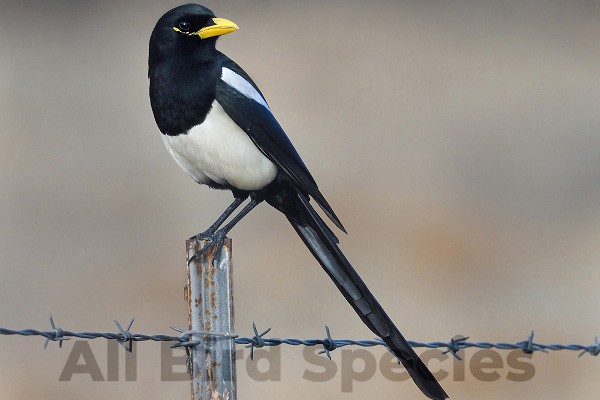
The yellow-billed magpie, scientifically known as Pica nuttalli, is a captivating species primarily found in California’s Central Valley. While its body is predominantly black, its white belly provides a striking contrast, and its bright yellow bill adds a touch of color.
| Feature | Description |
|---|---|
| Scientific name | Pica nuttalli |
| Common name | Yellow-Billed Magpie |
| Appearance | Predominantly black body with a contrasting white belly, bright yellow bill |
| Habitat | California’s Central Valley |
| Behaviors | Social, intelligent, known for their intricate nest-building skills |
The yellow-billed magpie is highly sociable and can often be seen in large groups, nesting in tall trees or foraging for insects and small vertebrates.
“The yellow-billed magpie’s stunning black-and-white appearance and vibrant bill make it a true gem among black birds with white belly.” – Birdwatching Magazine
7. Spotted Towhee (Pipilo maculatus)
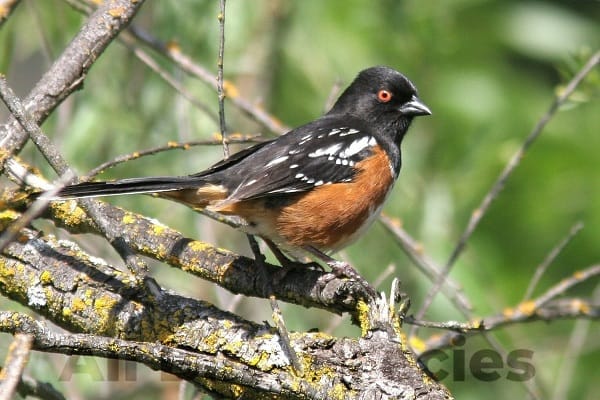
The spotted towhee, scientifically known as Pipilo maculatus, is a medium-sized bird that belongs to the family Emberizidae. It is primarily found in shrubby habitats across the United States, making it a popular sighting for birdwatching enthusiasts.
One of the most distinguishable features of the spotted towhee is its distinct black plumage and white belly, which perfectly contrasts against each other. This color pattern allows for easy identification, especially when observing the towhee foraging on the ground or perching on low branches.
Another notable characteristic of the spotted towhee is its vibrant red eyes, which add an intriguing touch to its appearance. These eyes, along with its dark plumage, create a striking visual contrast that captures the attention of bird enthusiasts.
In addition to its striking appearance, the spotted towhee is known for its unique song. Its melodic trill and series of distinct, musical notes make it a delightful songbird to listen to and identify in the wild.
Here’s an ID guide to help you recognize the spotted towhee:
| Feature | Description |
|---|---|
| Size | Medium-sized bird |
| Plumage | Black upper body with white belly |
| Eyes | Red in color |
| Song | Melodic trill with distinct musical notes |
Observing and identifying the spotted towhee can be a rewarding experience for bird lovers. Whether you spot it foraging on the ground for insects or hear its beautiful song resonating through the trees, the spotted towhee is a captivating addition to any birdwatching excursion.
8. Atlantic Puffin (Fratercula arctica)

The Atlantic puffin, scientifically known as Fratercula arctica, is a charming seabird that inhabits the coastlines of the North Atlantic. Adorned with a colorful beak and striking black-and-white plumage, this bird’s white belly contrasts beautifully with its overall appearance.
Distinctive Features
- The Atlantic puffin is known for its small stature, measuring about 10 inches in length.
- It features a unique triangular-shaped beak with vibrant orange, yellow, and blue colors, which become brighter during the breeding season.
- The bird’s black upper body is complemented by its signature white belly, creating a striking contrast.
- Atlantic puffins have short wings adapted for swimming underwater and flying with agility.
Habitat and Behavior
The Atlantic puffin spends most of its life at sea, only coming to land during the breeding season. These birds form large colonies, nesting in burrows on coastal cliffs and offshore islands. They are skilled divers and can swim underwater to catch their preferred diet of small fish and crustaceans.
“The Atlantic puffin’s unique appearance and fascinating behavior make it a true symbol of the North Atlantic coasts. Its white belly stands out as a captivating feature, adding to the bird’s undeniable charm.”
9. Eastern Towhee (Pipilo erythrophthalmus)
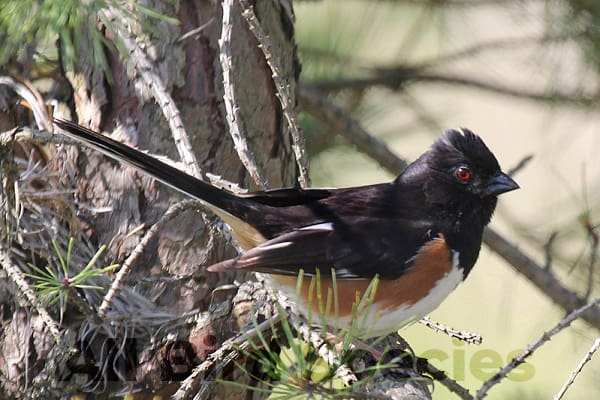
The eastern towhee, scientifically known as Pipilo erythrophthalmus, is a delightful bird found in eastern parts of North America. This species is recognized not only by its plumage but also its distinctive call. With a black upper body and contrasting white underbelly, the eastern towhee showcases the classic color combination of black birds with white belly.
| Eastern Towhee (Pipilo erythrophthalmus) | Description |
|---|---|
| Scientific Name | Pipilo erythrophthalmus |
| Geographic Range | Eastern parts of North America |
| Physical Characteristics | A black upper body with a contrasting white underbelly |
| Main Feature | Distinctive call |
10. Rose-Breasted Grosbeak (Pheucticus ludovicianus)

The Rose-Breasted Grosbeak, scientifically known as Pheucticus ludovicianus, is a migratory songbird that captivates birdwatchers with its stunning black-and-white plumage and elegant presence. These beautiful creatures visit the United States during the summer months, adding color and charm to forests and woodlands.
Male Rose-Breasted Grosbeaks showcase a striking contrast of black and white, with their black feathers adorned with a vibrant splash of rose-red on their breast. Their white bellies further enhance their visual appeal, creating a captivating sight. On the other hand, females sport more understated plumage with a streaked pattern of brown and white.
This species, belonging to the cardinal family, is celebrated not only for its appearance but also for its melodious song. Their rich, flute-like whistles fill the air, making them a joy to listen to during warm summer days. These songs play a vital role in territorial communication and courtship.
Did You Know?
The Rose-Breasted Grosbeak is known for its unique beak shape, which allows it to crack open seeds and consume fruit, making them important seed dispersers in their ecosystems.
These grosbeaks prefer to nest in heavily wooded areas, building their nests on branches near the canopy. Their nests are artfully constructed using twigs, bark, grass, and other plant materials, providing a safe haven for their young.
During migration, these birds cover impressive distances, flying from their breeding grounds in eastern and central North America to their wintering grounds in Central and South America. Their presence in the United States is highly anticipated by bird enthusiasts, who eagerly await their arrival.
Conservation Status
The Rose-Breasted Grosbeak is considered a species of least concern, with stable populations across its range. However, loss of forested habitats due to deforestation remains a potential threat to their long-term survival.
| Scientific Name | Common Name | Conservation Status |
|---|---|---|
| Pheucticus ludovicianus | Rose-Breasted Grosbeak | Least Concern |
11. Ring-Necked Duck (Aythya collaris)

The ring-necked duck, scientifically known as Aythya collaris, is a diving duck species commonly found in North America. This bird’s striking black plumage is beautifully contrasted by its distinctive white belly. One of its most distinguishing features is the ring around its neck, from which it derives its name.
These ducks prefer freshwater habitats such as marshes, ponds, and lakes, where they can dive and feed on aquatic plants, seeds, and invertebrates. They are skilled divers, capable of submerging and swimming underwater for extended periods in search of food.
During the breeding season, the male ring-necked ducks display a glossy black head, dark chestnut back, and the characteristic white ring around their neck, which is often difficult to see at a distance. Females, on the other hand, have a brown head and body with a smaller and less distinct white ring around their bill.



